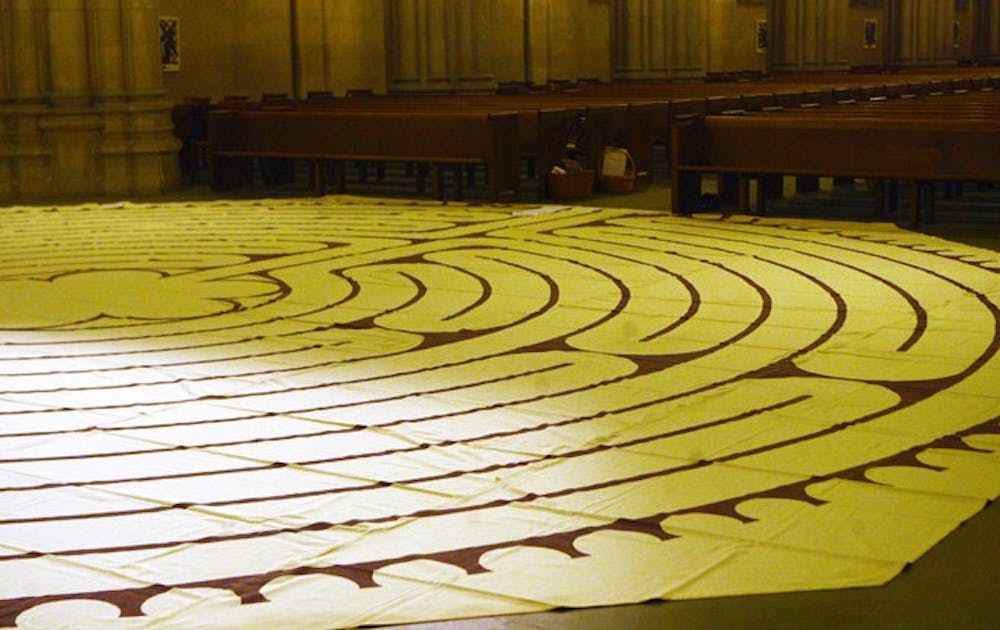Contrary to my own childhood memories, labyrinths do not contain goblin kings played by David Bowie, but rather are pathways that one can travel as a meditative practice. Throughout history, these circuitous pathways have maintained a presence in culture from our own contemporary outlook in movies like Pan’s Labyrinth to classical mythology involving Theseus and the Minotaur. This Tuesday, Mar. 5, members of the Duke community are invited to reflectively walk a labyrinth in the Duke Chapel in order to share in this age-old tradition.
“I see the labyrinth tradition as an opportunity to slow down, to deliberately and carefully walk the winding, meandering path,” said Meghan Feldmeyer, Director of Worship at the Duke University Chapel, in an email. “People of all religious faiths—or no religious faith—can find meaning in the quiet, contemplative aspects of walking the labyrinth in solidarity with the thousands of people who have done the same for centuries.”
Originally emerging in the early Bronze age as petroglyphs on artifacts, the labyrinth has been a prominent symbol in various cultures for centuries. A boulder on the Indus River in Pakistan boasts a carving of a labyrinth dating back two millennia. The Sanskrit epic, Mahabharata, bears mention of how Abhimanyu never learned how to escape the labyrinth and thus is fated to die at its center.
“Labyrinths are a very old pattern and practice with many appearances in the ancient world, from coins to gardens,” asserted Feldmeyer. “They began to make appearances in cathedral floors in the middle ages.”
In fact, the particular labyrinth used in the Duke Chapel is a replica of the Chartres Cathedral labyrinth constructed in the early 13th century. In accordance with its rich history, the labyrinth has come to be recognized as a tradition in its own right.
However, a labyrinth is not merely a symbol, but a practice. The act of traveling it is a right-brain practice of meditation. While a maze engages the spatial reasoning and analysis of the left brain, a labyrinth can engage the intuitive and receptive activity of the right brain. For some, the unicursal direction of a labyrinth is representative of the purposeful nature of each life—despite disconcerting twists and turns, the pathway has a singular way in and out. For others, this can also reflect the spiritual journey of identifying yourself internally before involving yourself externally with your community.
“On the circuit of this elongated path, the walker may feel lost, but one cannot get lost. The labyrinth is not a maze, there are no dead ends or confusing intersections, just one continuous path with many curves and turns that culminates at a center point,” said Sally Bates, Chaplain in the Duke Divinity School. “The slow pace, the repetition of the loops and curves on the pathway help to calm the body and clear the mind, and release tension.”
The insertion of the labyrinth into the Duke Chapel has been an annual Lenten tradition for many years at Duke. According to Bates, “the labyrinthine maze can provide a particularly meaningful opportunity to reflect on pilgrimage, sacrifice, and Jesus’ road to the cross.” Each Lent, a 40-foot canvas labyrinth is brought in by Jeanette Stokes from the Resource Center for Women & Ministry in the South. When guests arrive to walk the labyrinth, Stokes gives out a pamphlet detailing the three stages of the walk: letting go of the details that crowd your mind, illumination at the center of the labyrinth and integration by becoming empowered to go out in the world.
Although pilgrims can still walk the original Chartes labyrinth today, the replicated pattern is a reminder of the deep history of labyrinths stretching across time and geography. More than that, the labyrinth is a means by which walkers can engage in tradition and self-discovery.
“As we walk the labyrinth with others, we are reminded that we are all on a pathway of spiritual growth and discovery. We often meet other walkers on the pathway in our coming in and going out. It is a metaphor for our lives,” reflected Bates. “The gifts of the journey include peace, solace, insight, discovery.”
The labyrinth will be located in the nave of Duke Chapel from 8 a.m. to 6 p.m. on Tuesday, Mar. 5, and takes approximately 30 minutes to mindfully complete. Members of the Duke community can enter through the front door, remove their shoes, grab an information sheet and begin their own meditative journey.
Get The Chronicle straight to your inbox
Signup for our weekly newsletter. Cancel at any time.

